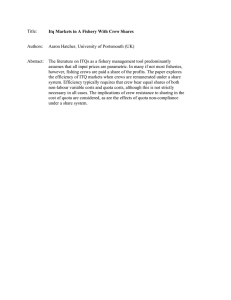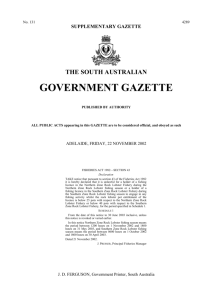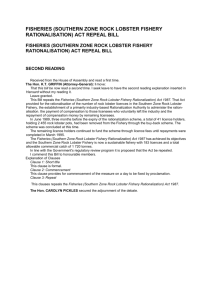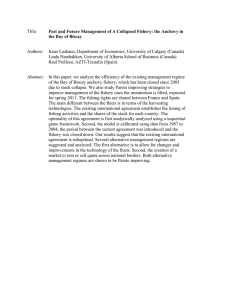Missed Opportunity for a Golden Handshake? Why Did So Many Fishers
advertisement
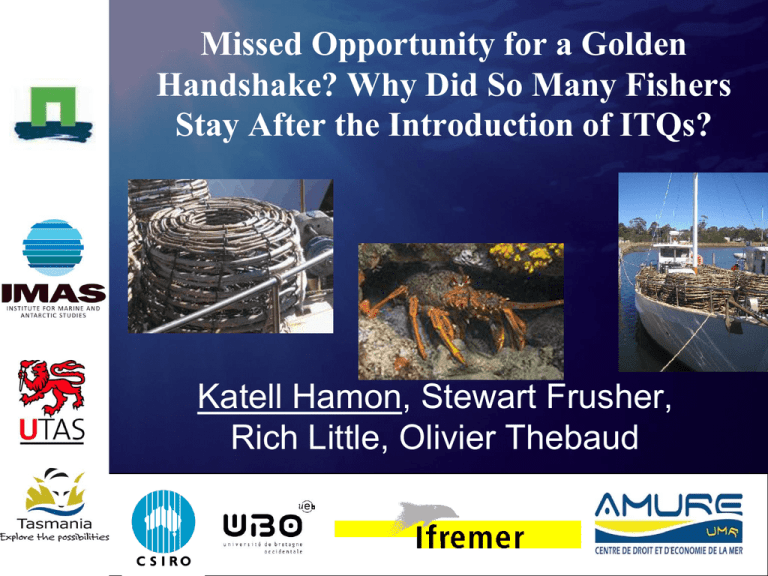
Missed Opportunity for a Golden Handshake? Why Did So Many Fishers Stay After the Introduction of ITQs? Katell Hamon, Stewart Frusher, Rich Little, Olivier Thebaud Outline –Tas rock lobster fishery – Model – Results – Discussion – Conclusion Outline • • • • • The Tasmanian rock lobster fishery Modelling the fleet Modelled vs real response Why the difference? Conclusion Outline –Tas rock lobster fishery – Model – Results – Discussion – Conclusion The Tasmanian rock lobster fishery Coastal fishery targeting single species Jasus edwardsii 215 vessels fishing with baited traps AUD $60 million return per year 75% landings exported ITQs introduced in 1998 Cap on quota ownership (<2%) Restrictive TAC Initial allocation based on trap ownership Outline –Tas rock lobster fishery – Model – Results – Discussion – Conclusion Heterogeneity of the fishery Spatial - Size - Colour - Fishers winter summer Seasonal - Price - Catch rates summer winter Outline –Tas rock lobster fishery – Model – Results – Discussion – Conclusion Expected vs Observed impacts of ITQ Sustainability of the resource Rationalisation of the fishing fleet if the TAC is set at a sustainable level transferability more efficient fishers buy out least efficient fishers the stock should rebuild Strategies maximizing return Concentration of quota ownership fishers develop fishing strategies maximizing the return on individual catch allocation socially not desirable 5 Outline –Tas rock lobster fishery – Model – Results – Discussion – Conclusion Modelling the fleet Inputs - catch & effort data - biological parameters - tagging data - economic data - quota info - vessel descriptors Management scenarios - TAC - Aggregation limits -… Lobster Price Fleet individual based - quota allocation - effort distribution (spatial & seasonnal) Outputs Quota Market - economic statistics - catch - stock state Outline –Tas rock lobster fishery – Model – Results – Discussion – Conclusion Begining of year Fishing plan Expected marginal profit $/kg ˆ1,2 ˆ2,2 ˆ3,2 ˆ4,2 ˆ1,3 ˆ2,3 ˆ3,3 ˆ4,3 ˆ1,4 ˆ2,4 ˆ3,4 ˆ4,4 Probability to be chosen met,month Fish Allocate quota to months Trade quota el Selection métier/month ve ss ˆ1,1 ˆ2,1 ˆ3,1 ˆ4,1 metiers Next month Metier's choice months metiers Next year Compute fishing plan months Outline –Tas rock lobster fishery – Model – Results – Discussion – Conclusion Begining of year Quota allocation ve ss months metiers Next year Compute fishing plan el Metier's choice Next month Total max catch:14 Allocate Quota owned : 5 quota to months Fish Trade quota 4 3 2 6 5 1 Outline –Tas rock lobster fishery – Model – Results – Discussion – Conclusion Begining of year Next year Compute fishing plan Quota trading ID profitable months 4 3 2 6 5 1 • Quota price Q Next month Trade quota Compare Demand/ Supply Profitable Demand/ Supply • Demand = Fill profitable months • Supply = quota in non profitable months Demand Supply Supply>Demand Allocate quota to decrease Q Demand>Supply months Increase Q Fish Q Q Outline –Tas rock lobster fishery – Model – Results – Discussion – Conclusion Begining of year Next year Fishing Compute fishing plan Next month Fish Allocate quota to months Trade quota • Allocate effort to areas for the month based on métier • Simultaneous catch of quota allocated to the month Outline –Tas rock lobster fishery – Model – Results – Discussion – Conclusion Modelled vs real response • Spatial distribution of catch: – predictions close to reality – anomalies in the western areas Outline –Tas rock lobster fishery – Model – Results – Discussion – Conclusion Modelled vs real response • Spatial distribution of catch: – predictions close to reality – anomalies in the western areas • Vessel exit – Stronger decrease predicted than observed Outline –Tas rock lobster fishery – Model – Results – Discussion – Conclusion Why the difference? • Interviews with members of the industry • Overestimation of fishing opportunities in some regions with high catch rates – Bad weather • Market is less dynamic in reality • temporary transfers only very flexible • only profit driven higher demand • Perfect knowledge vs 1st hand information Outline –Tas rock lobster fishery – Model – Results – Discussion – Conclusion Summary and Conclusion • Fishery reacted as predicted in trend but not in intensity • More inertia in the system than profit maximisation • Non-economic factors influence decisions – Personal factors – Weather constraints • Target “optimal” rather than “maximum” profit Thank you!
